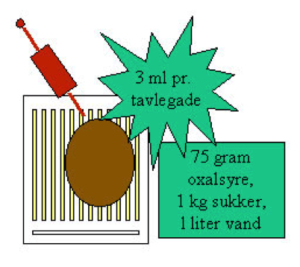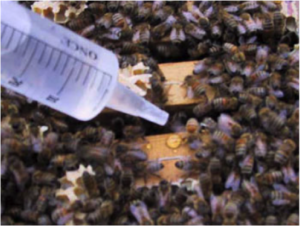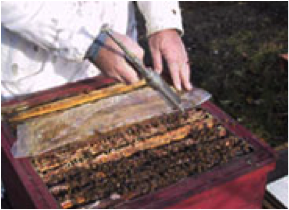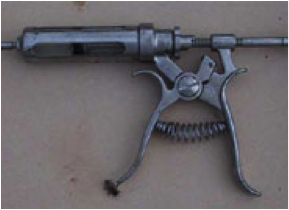Skrevet af: David Ashton
Oxalic Acid Trickling Method

The late season varroa – control is important. The treatment should take place when autumn feeding has finished, and the colony is free of brood.
OXALIC ACID TRICKLING
Oxalic acid is an organic acid, which is found naturally in honey. The method is extremely effective, very quick and inexpensive.
SAFETY
For varroa control the Oxalic acid is used in a very weak solution (3.2%). This solution is a very weak corrosive. But you must be very careful to avoid contact with the skin as oxalic acid can be absorbed through the skin. During treatment it is important to use acid resistant rubber gloves. Whilst mixing the solution you should use, gloves, safety goggles, and respirator (P2 Dust Mask).
TREATMENT IN BROOD FREE PERIOD
‘Oxalic Acid trickling’, does not work behind the brood cells sealed cap, this is the reason why treatment should take place in periods when none or very little brood as possible is present. We would normally recommend a treatment in late October – November (but account should be taken of climate for example in western seaboard of British Isles the gulf stream keeps the temperature up so brood rearing goes on into December) As the climate warms its important to check if brood rearing has stopped, so it could well be that treatment should take place in November or December. The important thing however is that the beekeeper must not fall in to the trap of forgetting to use an oxalic acid treatment. Bees, which for various different reasons go into winter and hibernation with too many mites, will suffer a large amount of damage and harm. One should there for in your considerations consider what is said. “ Treatment when brood free, so that those mite present can do the least amount of damage ” In other countries outside of Denmark, there is a tradition because of climate to give a much latter treatment!
It has previously been said that the colonies should be treated so the bees will have a couple of flying days after treatment. There is however no research that shows this to be necessary
MIXING THE SOLUTION
For the treatment then use oxalic acid – bi hydrate
The Oxalic Acid is mixed in proportions 1 litre distilled water: 1 kg sugar: 75 g oxalic acid – bi hydrate. This is enough for 55 colonies. You need to adjust this in proportion or use the Danish beekeepers oxalic acid calculator. You need to be aware that mixing very small amounts for example just two colonies for example, can create problems, as ordinary kitchen scales can give the wrong mixture. Consider weighing a minimum of 0.5 litre distilled water: 0.5 kg sugar: 37.5 grams oxalic acid – bi hydrate.
DURABILITY (SHELF LIFE)
When we only recommend autumn treatments, there is no reason to keep your surplus mixture; it is best put down the drain. If however you wish to keep your mixture, we should draw attention to the fact that it will keep up to six months in the dark in the cold of a cellar. The mixture should also be kept in child safe and secure bottle.
HOW TO USE IT?
The Oxalic Acid mixture should be look warm. You should use a 50 ml dosing syringe. You trickle 3- 3.5 ml per frame space with bees. That is to say 35 ml per colony. This is a very small quantity so it’s a good idea first of all to practise with ordinary water. It is important that the trickling takes place direct onto the bees and not just on the frame tops were the bees would let it lie.
TEMPERATURE
The outdoor temperature above 0 degree C
DAMAGE TO BEES
If the Oxalic Acid is used correctly, in the correct dosage there is no risk to the bees or the risk is very small. If you over dose then you can loose a lot of bees and weaken the colony.
HOW OFTEN SHOULD YOU TREAT?
Danish and international research has shown that if bees are treated more than once per generation, it can result in damage to the bees and a reduction in the strength of the colony. We recommend there for that you should only treat the bees once each season. The best time to treat is in the autumn early winter when the colony is brood free. We have however with large-scale beekeepers treated with success both in the autumn and in the spring with Oxalic Acid Trickling Method.


